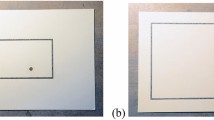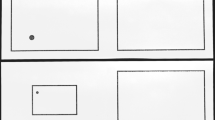Abstract
Recently, we have shown that a translating bar on which blindfolded participants position their hand is perceived as also rotating. Here, we investigated whether such an illusory rotation would also be found if a sphere or a plane (i.e. a stimulus without a clear orientation) was used as translating stimulus. We indeed found similar rotation biases: on average a stimulus that translates over a distance of 60 cm has to rotate 25\(^\circ \) to be perceived as non-rotating. An additional research question was whether the biases were caused by the same underlying biasing egocentric reference frame. To our surprise, the correlations between the sizes of the biases of the individual participants in the various conditions were not high and mostly not even significant. This was possibly due to day-to-day variations, but clearly, more research is needed to answer this second research question.
Access this chapter
Tax calculation will be finalised at checkout
Purchases are for personal use only
Similar content being viewed by others
References
Kappers, A.M.L., Bergmann Tiest, W.M.: Illusory rotation in the haptic perception of a moving bar. Exp. Brain Res. 231, 325–329 (2013)
Fernández-Díaz, M., Travieso, D.: Performance in haptic geometrical matching tasks depends on movement and position of the arms. Acta Psychol. 136, 382–389 (2011)
Kaas, A.L., Van Mier, H.I.: Haptic spatial matching in near peripersonal space. Exp. Brain Res. 170, 403–413 (2006)
Kappers, A.M.L.: Large systematic deviations in the haptic perception of parallelity. Perception 28, 1001–1012 (1999)
Kappers, A.M.L.: Large systematic deviations in a bimanual parallelity task: further analysis of contributing factors. Acta Psychol. 114, 131–145 (2003)
Van Mier, H.I.: Effects of visual information regarding allocentric processing in haptic parallelity matching. Acta Psychol. 144, 352–360 (2013)
Kappers, A.M.L.: Intermediate frames of reference in haptically perceived parallelity. In: 1st Joint EuroHaptics Conference and Symposium on Haptic Interfaces for Virtual Environment and Teleoperator Systems, pp. 3–11. IEEE Computer Society (2005)
Kappers, A.M.L.: Haptic space processing - allocentric and egocentric reference frames. Can. J. Exp. Psychol. 61(3), 208–218 (2007)
Kappers, A.M.L., Schakel, W.B.: Comparison of the haptic and visual deviations in a parallelity task. Exp. Brain Res. 208, 467–473 (2011)
Coren, S.: The Left-Hander Syndrome. Vintage Books, New York (1993)
Cohen, Y.E., Andersen, R.A.: A common reference frame for movement plans in the posterior parietal cortex. Nat. Rev. Neurosci. 3, 553–562 (2002)
Flanders, M., Soechting, J.F.: Frames of reference for hand orientation. J. Cogn. Neurosci. 7, 182–195 (1995)
Paillard, J.: Motor and representational framing of space. In: Paillard, J. (ed.) Brain and Space, pp. 163–182. Oxford University Press, Oxford (1991)
Acknowledgments
This work has been supported by the European Commission with the Collaborative Project no. 248587, THE Hand Embodied, within the FP7-ICT- 2009-4-2-1 program Cognitive Systems and Robotics.
Author information
Authors and Affiliations
Corresponding author
Editor information
Editors and Affiliations
Rights and permissions
Copyright information
© 2014 Springer-Verlag Berlin Heidelberg
About this paper
Cite this paper
Kappers, A.M.L., Tiest, W.M.B. (2014). Illusory Rotations in the Haptic Perception of Moving Spheres and Planes. In: Auvray, M., Duriez, C. (eds) Haptics: Neuroscience, Devices, Modeling, and Applications. EuroHaptics 2014. Lecture Notes in Computer Science(), vol 8619. Springer, Berlin, Heidelberg. https://doi.org/10.1007/978-3-662-44196-1_11
Download citation
DOI: https://doi.org/10.1007/978-3-662-44196-1_11
Published:
Publisher Name: Springer, Berlin, Heidelberg
Print ISBN: 978-3-662-44195-4
Online ISBN: 978-3-662-44196-1
eBook Packages: Computer ScienceComputer Science (R0)




